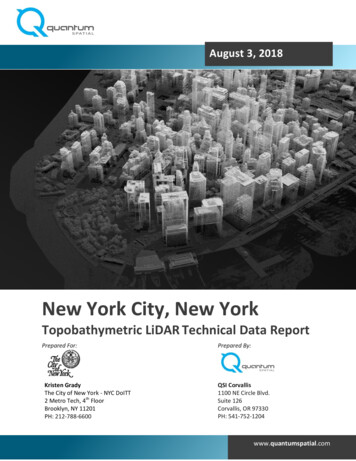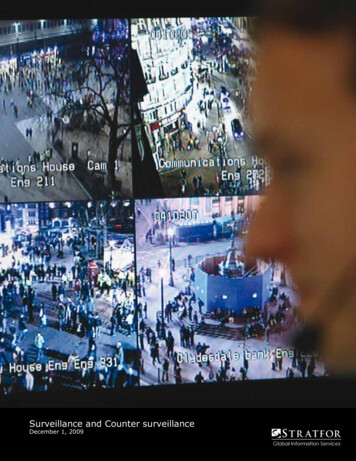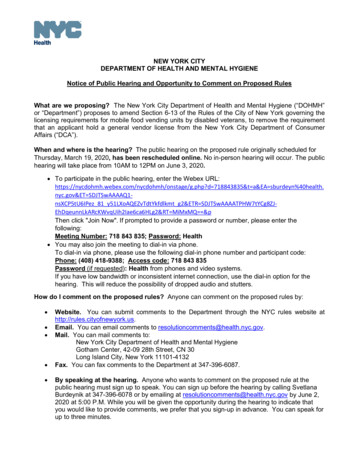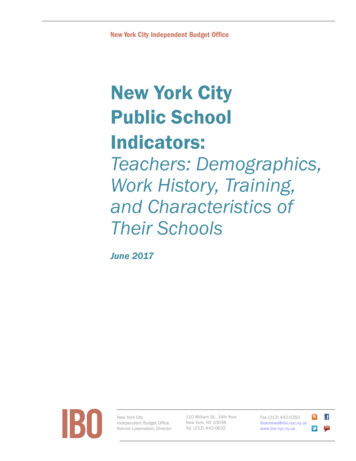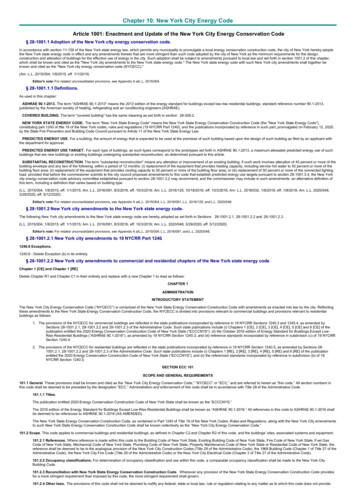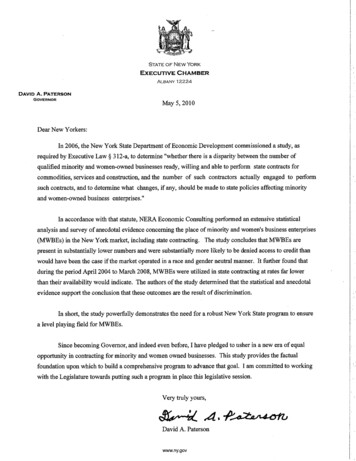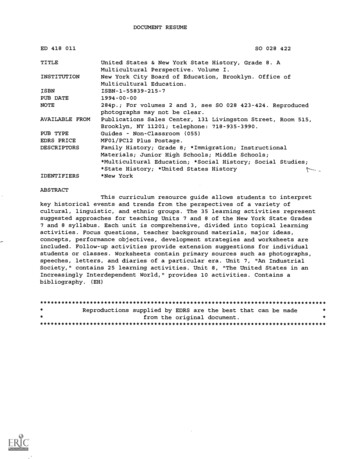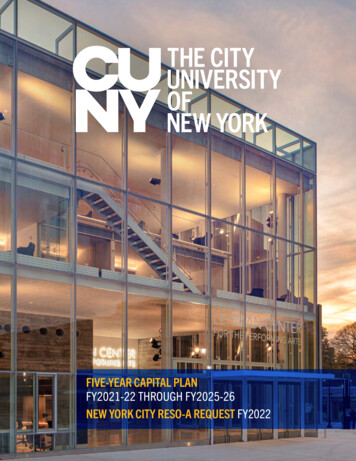
Transcription
FIVE-YEAR CAPITAL PLANFY2021-22 THROUGH FY2025-26NEW YORK CITY RESO-A REQUEST FY2022
Governance & AdministrationBoard of TrusteesWilliam C. Thompson Jr.ChairpersonMichael ArvanitesHenry T. BergerUna S. T-ClarkeLorraine Cortés-VázquezFernando FerrerKevin D. KimMayra Linares-GarciaRobert F. MujicaBrian D. ObergfellJill O’Donnell-TormeyCharles A. ShorterKen SunshineSandra Wilkin25 CollegesKenneth AdamsLaGuardia Community CollegeMichelle J. AndersonBrooklyn CollegeSarah BartlettCraig Newmark Graduate Schoolof JournalismMary Lu BilekCUNY School of LawVincent BoudreauThe City College of New YorkRudolph F. CrewMedgar Evers CollegeDaisy Cocco De Filippis, InterimEugenio María de Hostos Community CollegeFernando DelgadoLehman CollegeMartin J. Burke (ex-officio)Chairperson, University Faculty SenateJuvanie Piquant (ex-officio)Chairperson, University Student SenateGayle M. HorwitzSecretary of the Board andSenior Advisor to the ChancellorAdministrationFélix V. Matos Rodríguez ChancellorJosé Luis CruzExecutive Vice Chancellor andUniversity ProvostHector BatistaExecutive Vice Chancellor andChief Operating OfficerDerek DavisGeneral Counsel andSenior Vice Chancellor for Legal AffairsGlenda GraceSenior Vice Chancellor for Institutional Affairs,Strategic Advancement and Special CounselAyman El-MohandesCUNY Graduate School of Public Healthand Health PolicyWilliam J. FritzThe College of Staten IslandRobin L. GarrellCUNY Graduate CenterRussell K. HotzlerNew York City College of TechnologyThomas A. IsekenegbeBronx Community CollegeLarry D. Johnson Jr.Stella and Charles Guttman Community CollegeBerenecea Johnson EanesYork CollegeChristine ManginoQueensborough Community CollegeGregory MantsiosCUNY School of Labor and Urban StudiesMatthew SapienzaSenior Vice Chancellor andChief Financial OfficerPamela S. SilverblattSenior Vice Chancellor for Labor RelationsBrian CohenVice Chancellor andUniversity Chief Information OfficerDoriane K. GloriaVice Chancellor of HumanResources ManagementMaite JuncoVice Chancellor for Communicationsand MarketingDenise Maybank, InterimVice Chancellor for Student Affairsand Enrollment ManagementAndrea Shapiro Davis, InterimVice Chancellor for University AdvancementRichard R. WhiteVice Chancellor for Risk, Audit and ComplianceDolly MartinezChancellor’s Chief of Staff and AssociateVice Chancellor for the Executive OfficeKarol V. MasonJohn Jay College of Criminal JusticeJohn MogulescuCUNY School of Professional StudiesAnthony E. MunroeBorough of Manhattan Community CollegeMary C. PearlWilliam E. Macaulay Honors CollegeJennifer J. RaabHunter CollegeClaudia V. SchraderKingsborough Community CollegeFrank H. WuQueens CollegeS. David WuBaruch CollegeCUNYFY2021BUDGETREQUEST Inc.23Cover Photo Copyright Paul Warchol,PaulWarcholPhotography
1 University 25 Colleges1234567BRONXBronx CommunityCollegeEugenio María de HostosCommunity CollegeHerbert H. LehmanCollege89101112BROOKLYNBrooklyn CollegeKingsboroughCommunity CollegeMedgar Evers CollegeNew York City Collegeof Technology13141516171819Community CollegesMANHATTANBernard M. Baruch CollegeBorough of ManhattanCommunity CollegeThe City College of New YorkCraig Newmark GraduateSchool of JournalismCUNY Graduate CenterCUNY Graduate School ofPublic Health and Health PolicyCUNY School of Labor andUrban StudiesCUNY School ofProfessional StudiesHunter CollegeJohn Jay College ofCriminal JusticeStella and Charles GuttmanCommunity College1013William E. Macaulay19Honors CollegeMANHATTAN17Four-Year CollegesProfessional & Graduate Schools141118151224QUEENSCUNY School of LawLaGuardia Community CollegeQueens CollegeQueensboroughCommunity CollegeYork College25STATEN ISLANDCollege of Staten YN425STATEN ISLAND5 Budget Request Bro FY2021 UPDATEfor2022.indd 331/8/21 3:05 PM
The Chancellorchancellor@cuny.edu205 East 42nd Street, 18th floorNew York, NY 10017646 664-9100 tel646 664-3868 faxFebruary 5, 2021Governor Andrew M. CuomoMayor Bill de BlasioMembers of New York State LegislatureMembers of New York City CouncilNew York City Borough PresidentsThe City University of New York serves a historic mission – providing exceptional access to anoutstanding, affordable education and assisting our diverse community of students in laying thegroundwork for promising, prosperous careers. I am proud of our professors’ and staff’s swifttransition to distance learning and their ongoing efforts to support New York and its citizensduring the pandemic.As a result of COVID-19, CUNY conducted nearly all classes remotely for the past year. As welook ahead to resuming in-person education safely, CUNY has developed higher standards forbuilding ventilation and is continuing to assess how best to incorporate our recent public healthlessons into the design and operation of our facilities. The capital plan outlined herein reflectsthose priorities. Designs for capital renewal projects will include new criteria to improve theindoor air quality for our buildings and the latest public health information to insure the healthand safety of our community.What began as The Free Academy in 1847 has become a preeminent public education systemfocused on serving all New Yorkers, particularly those from low-income, underrepresented andimmigrant groups. Our 25 colleges, graduate and professional schools educate more than270,000 degree-seeking students. We are continuously assessing priorities, aiming to increase theUniversity’s momentum and seeking the consistent improvement of outcomes. COVID-19 hasmade us redouble our efforts to update our technology to ensure quality access to data andsupport for our students. We are also working on updating our HVAC and installing filters asappropriate to improve air quality indoors.The University plays a vital role in creating opportunities for all New Yorkers, no matter theirbackground, and it provides the talented workforce that sustains this city’s stature as thefinancial, media, health care and cultural capital of the country. A robust capital program isessential to our fulfillment of this special mission, now and for the future. Existing structuresmust be renovated, and new facilities built to high standards of efficiency and quality forinstruction, research and campus life. We do that with a bolstered commitment to meeting thestate’s MWBE contracting goals.
Because of the University’s reach across all five boroughs, CUNY maintains the country’slargest urban system of public higher education facilities. Our campuses encompass 300 separatebuildings, and the average building age exceeds 50 years. Strong enrollment has enabled us tohelp more New Yorkers thrive, but it has also strained our facilities. We address these needs withthe capital program.CUNY’s capital priorities over the next five years include ensuring the health, safety andsecurity of our facilities and working toward a state of good repair on our senior and communitycollege campuses, along with initiating and completing construction of new and expandedfacilities. Projects underway include the new Nursing Education and Research Practice Center atLehman College; the Central Kitchen and Dining Center at Queensborough Community College;and the second phase of renovation of the 90-year-old Lawrence and Eris Field Building on the1847 site of The Free Academy, the historic hub and sentimental heart of Baruch College. Weneed to ensure that our facilities provide the classrooms, laboratories, library and study space thatsupport the creativity, ambition and hard work of our students.We greatly appreciate the capital support provided by the state and the city over the past decade,which has been critical. We ask for your continued support to help us to sustain our progress.This year instead of sending you a book of the five year request, we are sending a link where allthe details of CUNY’s five year request can be /offices/fpcm/departments/capital-budget/Thank you again for your valued partnership.Sincerely,Félix V. Matos Rodríguez, Ph.D.
ContentsThe City University of New YorkFive-Year Capital Plan FY 2021-22 through FY 2025-26New York City Reso-A Request FY 2022Introduction . 1Summary of RequestFive-Year Capital Plan FY 2021-22 through FY 2025-26 Summary . 9Five-Year Capital Plan FY 2021-22 through FY 2025-26 Details. 10New York City Reso-A Request FY 2022 Details . 15Individual Campus SectionsCUNY-Wide Senior Colleges . 19CUNY Information Technology Initiatives . 25Baruch College . 29Brooklyn College . 35City College . 41CUNY Law. 47Graduate Center . 52Graduate School of Journalism . 57Graduate School of Public Health . 62Hunter College . 66John Jay College of Criminal Justice. 74Lehman College. 79Macaulay Honors College . 85Medgar Evers College . 89New York City College of Technology. 95Queens College. 101School of Labor and Urban Studies . 107School of Professional Studies . 112College of Staten Island . 117York College . 123CUNY-Wide Community Colleges . 129BMCC (Borough of Manhattan Community College) . 133Bronx Community College. 139Guttman Community College. 147Hostos Community College . 151Kingsborough Community College . 157LaGuardia Community College . 164Queensborough Community College . 170Hunter College Campus Schools . 176Appendix: Building Inventory Summary . 180
FY 2022 Capital Budget Request PrioritiesThe City University of New York Capital Budget RequestFY 2022In recognition of the economic impact of the pandemic to New York State and City, CUNY is limiting itsoverall request and is not asking for any strategic initiative funding this fiscal year. The overall fiveyear capital plan does include strategic initiatives.This year the University prioritized the following two projects in its capital budget request:Prioritizing Cloud Based SolutionsIn a year when CUNY had to pivot to full on-line learning temporarily, IT priorities came to the forefront.CUNY has to address its fast-moving IT needs; sitting still means falling behind, and for an educationalinstitution that is not an option. Consequently, we are prioritizing a request to for funds to act uponconsultant recommendations as that we transition more of our IT operations to the Web.CUNY has been investing in a consolidated IT infrastructure for the last decade. While it was atremendous upgrade, IT solutions are changing at a rapid pace and new technologies are beginningto replace what CUNY uses. CUNY’s current strategic IT roadmap transitions the University to cloudbased systems and solutions where available and practical. Some of these changes are currentlybeing worked on and others are not yet available. The benefits of this approach include: the ability toadapt to fast changing technology, bring solutions to our students and other end users faster, andoffer features and functions that one expects in a highly regarded higher education institution. Inaddition, moving to modern cloud solutions will provide CUNY with greater control over its datacurrently housed in hosted systems not under CUNY’s management, replace paper and manualbusiness processes to digital workflows, and centralize data currently located in systems managed byCUNY colleges and outside service providers, including government agencies and retirementprograms.The first phase of this multi-phase effort will focus on the needs of our human resources operationsand professionals. Future phases will include finance and student management functions andoperations.Our plans are also to update and move end-of-life phone and emails systems located throughout theUniversity to cloud based solutions. We will leverage an enterprise strategy and approach and provideimproved unified communications and collaboration systems and high-demand services. Thesemodern integrated cloud solutions will provide the foundation and opportunity for savings throughconsolidated procurements and technology support models.First Year Request 75 million1
University Wide Upgrade of Science LabsThe intent of this project is to implement renovation of science spaces systematically and aggressivelythroughout CUNY to support current pedagogy and research activities while improving student successand retention. While the teaching and practice of science has changed significantly over the past 30 years, many of CUNY’s laboratory facilities have not kept pace. Laboratory systems, finishes, andfurnishings are well past their useful lives and the layouts of existing laboratories do not supportcurrent practices. While new construction and renovation projects have provided significant yetisolated improvements, much of CUNY’s existing laboratory inventory has not been significantlyupdated since its original construction. A CUNY-wide effort is needed to prioritize needs and maximizethe effectiveness of available funding. Significant funding is requested to boost the start of thisaggressive program. The first few years of the project will identify and design groups of labs to beaddressed.First Year Request 50 million2
IntroductionThe City University of New York Five-Year Capital Improvement PlanFY 2021-22 through FY 2025-26New York City Reso-A Plan FY 2022Located in all five boroughs of New York City, the facilities at CUNY’s campuses include the traditionaland the innovative. The University has 300 buildings comprising 29 million square feet of classrooms,instructional and research labs, computer centers, theaters, athletic and recreational facilities,academic and administrative offices, and other spaces supporting CUNY’s students and mission.The focus of CUNY’s Five-Year Capital Plan’s is on maintaining and improving facilities essential tostudent success. The projects included in the capital plan preserve the University’s infrastructure,recapture underutilized spaces, improve technology and provide for campus expansion wherenecessary. It is only through upgrading the University’s facilities portfolio that CUNY will be able tocontinue providing the city and region with graduates trained for high-demand positions in thesciences, technology, mathematics, teaching, nursing and other fields.The Capital Plan and the Covid-19 PandemicAs a result of COVID-19, CUNY conducted nearly all classes remotely for the past year. As we lookahead to resuming in-person education safely, CUNY has developed higher standards for buildingventilation and is continuing to assess how best to incorporate our recent public health lessons intothe design and operation of our facilities. The capital plan outlined herein reflects those priorities.Designs for capital renewal projects will include new criteria to improve the indoor air quality for ourbuildings and the latest public health information to insure the health and safety of our community.Potential projects include: installing more efficient air filters (MERV-16 or, at the minimum, MERV-13filters) on air handling systems in buildings; installing ultraviolet (UVC) lighting system on the airhandling units to enhance indoor air quality; installing UVC lighting systems in spaces where required;increased ventilation at certain locations; and installing more advanced optimized buildingmanagement systems to have better control on the air dampers, enabling the more effectiveintroduction of outside air to the interior spaces.Significant HVAC and air-quality related projects are in planning at CUNY. Some examples of projectsin the detailed capital plan include: City College - Steinman Hall HVAC upgrades; Graduate Center UVC Sanitizing Lighting for Rooms and HVAC; Hunter College - North Building HVAC Ph. I; LehmanCollege - Carman Hall Univent and Fan Coil Replacement; and, Medgar Evers College Carroll StreetBuilding Infrastructure Upgrades Phases 2 and 3.The Capital PlanThe University’s Five-Year Capital Plan for FY 2021-2022 through FY 2025-26 is 5.53 billion: 4.154billion for the senior colleges, professional and graduate schools, and 1.37 billion for the community3
colleges. By program need, the Five-Year Plan breaks down to 3.627 billion for capital renewal andminor repair and 1.899 billion for strategic initiatives. The State provides 100% of the capital fundingfor the senior colleges; the City shares 50% of the funding responsibility for the community collegeswith the State, as per New York State education law that requires equal state-city “matching” fundingfor community colleges.The Five-Year Capital Plan was developed by the CUNY Office of Facilities Planning, Construction andManagement in consultation with CUNY colleges and schools. The University’s priorities are: An ongoing Capital Renewal initiative to address health, safety, security, facilities preservationand code issues and bring CUNY campuses to a state of good repair. Completion of active and ongoing work. Many important projects have been designed and areawaiting funding to begin construction. Technology projects, including infrastructure upgrades, systems engineering, and newequipment that will allow the University to develop integrated data services at the campusesand across the system. The Plan also includes a funding request to continue to enhanceCUNY’s ability to effectively deliver online learning opportunities. Projects to meet energy conservation and performance objectives, including the ClimateLeadership and Community Protection Act (CLCPA), BuildSmart 2025 and Local Law 87. Strategic Initiatives for new construction of space needed for academic programs. Highestpriority is assigned to classroom and instructional laboratory facilities and to the replacementof temporary or leased space with permanent facilities. The University’s Plan defers the needfor strategic initiative funding until FY 2022-23 in order to focus the university on the prioritieslisted above.For City Fiscal Year 2022, the University also is plans 99 million in discretionary (Reso-A) fundingfrom the New York City Council and borough presidents to address smaller-scale projects.Since 2011, CUNY has received over 3.6 billion in funding to address senior college facilities renewaland strategic initiatives. As a result, CUNY has initiated and completed a considerable number ofprojects, benefiting virtually every CUNY senior college campus.Allocations and project completions have been slower for the community colleges because of the needto match funding before it can be used. The city must provide its 50% share of funds first and thestate’s match is typically provided in the following state fiscal year budget (approximately nine monthslater).Capital Renewal: Investment in Existing FacilitiesOne of the most significant issues affecting CUNY’s capital program is the age of its facilities. TheUniversity’s facilities portfolio consists of 29 million square feet in 300 buildings across 25campuses. The average building at CUNY is more than 50 years old; most are over 30 and someexceed 100.4
CUNY’s Capital Renewal program aims to undertake the work necessary to keep buildings andinfrastructure operating effectively in support of the educational mission; without this, students andfaculty cannot do their best work.The Capital Infrastructure and Equipment Funding Need includes projects that: extend the life of CUNY facilities. provide life/safety enhancements and meet code requirements. improve operational efficiency, including energy conservation. support academic programs and enhance the University’s mission by modernizing spaces foracademic, student life, and student services.Frequently, facility conditions dictate the need for projects that combine upgrade of building orcampus-wide infrastructure systems (e.g. heating, ventilation and cooling, electrical, plumbing, andbuilding envelopes), followed by modernization of instructional and support space.Since 2007, CUNY has analyzed and reported on the state-of-good-repair of its facilities. Most recently,in 2020, CUNY undertook a self-audit of its 254 owned buildings using life-cycle methodology. Theanalysis identified the University’s backlog of deferred maintenance and projected anticipated futureneeds which together are used to shape CUNY’s Facilities Renewal request. This analysis identified a 4.3 billion backlog, with 6.8 billion needed over the next five years to fully address both the deferredmaintenance backlog and ongoing renewal.5
Life Cycle Renewal Need by Asset Type1-5 YEARS 2.5BBACKLOG 2.0B 1.5B 1.0B 0.5B 0.0BCurrent Capital Infrastructure and Equipment Needs by System6
Implementation of energy efficiency goalsCUNY’s capital program and conservation initiatives reflect the University’s commitment to sustainabletechnology and energy efficiency. New CUNY buildings and major renovations will be a minimum ofLEED-certified Silver or equivalent. CUNY’s capital program and associated initiatives are guided bythe following energy and environmental State and City mandates:State: CLCPA, BuildSmart 2025 and Executive Order 166:The new Climate Leadership and Community Protection Act (CLCPA) requires the State to achieve acarbon-free electricity system by 2040 and reduce emissions 85% by 2050 from 1990 levels, with aninterim goal of 40% by 2030.CUNY’s senior colleges also participate in BuildSmart 2025 which has a target of 11 trillion Britishthermal units (TBtu) of building site energy savings at State Entities by December 31, 2025. ExecutiveOrder 166 mandates that State Entities reduce greenhouse gas (GHG) emissions 40% by 2030 and80% by 2050.City: NYC Climate Mobilization Act; including Local Laws 33, 45,84, 86, 87, 88, 92,97; and ExecutiveOrder 26:CUNY’s community colleges are reducing GHG and energy use in an effort to meet the targets set bythe Climate Mobilization Act and local laws that mandates a reduction in carbon emissions of 80percent by 2050.To ensure progress and comply with the above mandates, Sustainable CUNY’s CUNY ConservesProgram analyzes energy data in order to identify needed changes to meet targets. In addition, CUNYhas established an Energy Efficiency Working Group to coordinate the associated operating and capitalmeasures.CUNY is developing a five-year carbon and energy reduction plan to meet the NYC Climate MobilizationAct mandates at the Community Colleges. Measures include implementation of high-efficiencyfluorescent and LED lighting technology; the upgrading, renewal and/or expansion of digitalenvironmental control systems; retro-commissioning of CUNY buildings; and installation of real-timeutility metering and building sub-metering systems.In addition to the efficiencies gained by our capital investments in new and more efficient facilities,the Sustainable CUNY Conserves program continues to implement projects and measures that providerapid returns on investment as well as immediate energy reductions. The projects range fromoptimizing building automation systems to efficient lighting controls to utilization of real time energymanagement systems to manage peak load.7
Economic impact and Minority- and Women-Owned Business Enterprises (MWBEs)On behalf of CUNY, the City University Construction Fund (CUCF) spends over 300 million each yearon construction in New York City, supporting thousands of jobs throughout the city. Since the beginningof Governor Andrew M. Cuomo’s Minority- and Women-owned Business Enterprises (MWBEs) initiativenine years ago, over 225 million of the funds appropriated to CUCF for design and constructionprojects managed by CUCF has gone to New York State-certified MWBE firms. This accounts for anaverage of almost 28% of the total reportable spending of about 813 million during that nine-yearperiod. CUCF also works closely with the Dormitory Authority of the State of New York (DASNY), whichsupports the University’s capital plan. The strong commitment of CUCF and DASNY to the state’sMWBE program is evidenced by their combined NYS FY 19/20 MWBE expenditures of over 299million.The successful long-term performance of CUCF’s program is the result of building contractualrelationships at multiple tiers, including prime contractors, with a large number of MWBEs. In addition,since its introduction in 2016, the initiative for Service-Disabled Veteran-Owned Business (SDVOB) hasalso grown. Through both programs, CUCF continues to expand its network of MWBE and SDVOB firmsand opportunities. In August 2019, CUNY/CUCF held its 11 th annual MWBE/SDVOB conference,attracting approximately 1,200 attendees. While the COVID-19 pandemic impacted 2020 outreachefforts, CUCF was a sponsor and participant in the Competitive Edge Virtual SDVOB conference, and aparticipant in the NYS Virtual MWBE Forum.Value of Investing in CUNY’s Capital programCapital Construction is a known strong economic engine to restart economies. CUNY has been a majorpart of that process for New York State and City. Every Year CUNY’s capital spending generatesthousands of jobs for the local economy.Public-private initiativesCUNY Office of Facilities Planning, Construction and Management endeavors to finance and developnew facilities for the University by monetizing CUNY’s real estate assets, creating revenue-supportedprojects and using the efficiencies of the private sector.8
Summary of Five-Year PlanFive-Year Capital Plan FY 2021-22 through FY 2025-26Summary(Amounts in thousands)Seniors, Professional & GraduateBondedStrategic InitiativesMinor RehabilitationTotalFY 21-22FY 22-23FY 23-24FY 24-25FY 25-26Five-Year Plan 599,754 537,920 529,050 459,734 375,301 2,501,760 0 409,950 135,000 718,900 123,950 1,387,800 51,246 52,031 52,832 53,649 54,482 264,240 651,000 999,901 716,882 1,232,283 553,733 4,153,800Community CollegesBondedStrategic InitiativesMinor RehabilitationTotalFY 21-22FY 22-23FY 23-24FY 24-25FY 25-26Five-Year Plan 154,800 197,595 152,816 169,895 165,695 840,800 0 295,000 175,000 41,000 0 511,000 4,000 4,000 4,000 4,000 4,000 20,000 158,800 496,595 331,816 214,895 169,695 1,371,800University Total 809,800 1,496,4969 1,048,699 1,447,177 723,428 5,525,600
Five-Year Capital Plan FY 2021-2022 through FY 2025-2026 DetailsSenior Colleges, Professional & Graduate SchoolsFY 21-22Amounts in thousandsCollege / ProjectCUNY-Wide Senior CollegesCapital Infrastructure and Equipment (Seniors)Health and SafetyFacilities PreservationMEP Infrastructure UpgradesADAC. of O. / P.A. ProgramEn
Craig Newmark Graduate School of Journalism Mary Lu Bilek CUNY School of Law Vincent Boudreau The City College of New York Rudolph F. Crew Medgar Evers College Daisy Cocco De Filippis, Interim Eugenio María de Hostos Community College Fernando Delgado Lehman College Ayman El-Mohandes CUNY Graduate School of Public Health and Health Policy .


